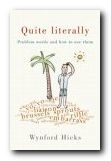free pages from our English Language software program
Pronouns – definition
![]() Pronouns stand instead of nouns (to avoid repeating them).
Pronouns stand instead of nouns (to avoid repeating them).
Examples
![]() Personal pronouns stand instead of names:
Personal pronouns stand instead of names:
I me you he him we us they them
![]() Relative pronouns act as reference links:
Relative pronouns act as reference links:
which who that
Use
![]() Pronouns are frequently used in both speech and writing .
Pronouns are frequently used in both speech and writing .
![]() By using them we are able to avoid frequent repetition of a name. Compare these statements.
By using them we are able to avoid frequent repetition of a name. Compare these statements.
![]() First, the proper noun John is used throughout.
First, the proper noun John is used throughout.
John’s in the Army and John looks good in John’s uniform as John strides along.
![]() Second, the proper noun is used initially and followed by pronouns.
Second, the proper noun is used initially and followed by pronouns.
John’s in the Army and he looks good in his uniform as he strides along.
![]() NB! Fasten your safety belt. There’s a lot more on this topic.
NB! Fasten your safety belt. There’s a lot more on this topic.
![]() There are several different kinds of pronouns. These can be classified as personal, possessive, reflexive, emphatic, demonstrative, interrogative, exclamatory, relative, and pronouns of amount and number.
There are several different kinds of pronouns. These can be classified as personal, possessive, reflexive, emphatic, demonstrative, interrogative, exclamatory, relative, and pronouns of amount and number.
![]() Personal pronouns derive from the grammatical term ‘person’. This itself is of Latin origin [dramatis personae] meaning characters in a play. This term has been transferred to the characters in a story or dialogue, which may be shown as follows:
Personal pronouns derive from the grammatical term ‘person’. This itself is of Latin origin [dramatis personae] meaning characters in a play. This term has been transferred to the characters in a story or dialogue, which may be shown as follows:
Singular Plural I we NOMINATIVE you you he, she, it they me us ACCUSATIVE you you him, her, it them
![]() Possessive pronouns denote possession as in the following example:
Possessive pronouns denote possession as in the following example:
The dress was mine and now its hers.
![]() Possessive pronouns follow the same pattern as the personal pronouns:
Possessive pronouns follow the same pattern as the personal pronouns:
Singular Plural mine
yours
hers, his, itsmine
yours
theirs
![]() Reflexive pronouns are often used as objects of verbs. For example:
Reflexive pronouns are often used as objects of verbs. For example:
I found myself rolling down the hillside.
He gave himself a pat on the back.
![]() Reflexive pronouns are also used with prepositions, as in:
Reflexive pronouns are also used with prepositions, as in:
I felt the sadness sweeping over me.
She pulled the blanket over her.
Bring your friends with you.
![]() After a preposition, the pronoun looks like a plain personal pronoun; but the context is reflexive. The archaic usage perhaps makes this case more clear, as in:
After a preposition, the pronoun looks like a plain personal pronoun; but the context is reflexive. The archaic usage perhaps makes this case more clear, as in:
Now I lay me down to die
![]() Emphatic pronouns are used in such contexts as:
Emphatic pronouns are used in such contexts as:
I’d like a glass of wine please, and (you) have one yourself.
(emphasising who must have one)She herself wanted to join the company.
(emphasising the subject of the sentence)
![]() Demonstrative pronouns are used for pointing things out to the listener. They are:
Demonstrative pronouns are used for pointing things out to the listener. They are:
this, these (nearby) that, those (at some distance) such (meaning ‘such as’) same (meaning ‘the same as’) These are the best flowers in the shop.
Those are the Alps in the distance.
They have such exciting parties.
I asked for a box and was sent the same.
![]() Interrogative pronouns are used to ask questions. They are:
Interrogative pronouns are used to ask questions. They are:
who? whom? whose? which? what? Who was at the party?
Whom did you see at the party?
Whose friend was the woman in the red dress?
Which dish did you most enjoy?
What did you do all evening?
![]() Exclamatory pronouns. The word ‘what’ is often used to exclaim on an issue in the following way:
Exclamatory pronouns. The word ‘what’ is often used to exclaim on an issue in the following way:
What a night!
What she could have achieved!
![]() Relative pronouns are as follows:
Relative pronouns are as follows:
who whom whose which that what as Those who arrive early can begin.
The woman whom I met sent me a postcard.
We met the couple whose house we bought.
Those tins which we brought came in useful.
I always write about topics that interest me.
I always mean what I say.
It was as beautiful a garden as ever I saw.
![]() Pronouns of number are as follows:
Pronouns of number are as follows:
one more few neither enough One of them was ill.
Neither of the girls had a raincoat.
Few people understand the value of money.
More people may join the club next week.
Enough is as good as a feast.
![]() Pronouns of amount are as follows:
Pronouns of amount are as follows:
anyone nobody something everybody
![]() These are used as in the following statements:
These are used as in the following statements:
Anyone who had a heart would take her.
Everybody gathered round the lake.
Something will have to be done about the food.
Self-assessment quiz follows >>>
© Roy Johnson 2003
English Language 3.0 program
Books on language
More on grammar
